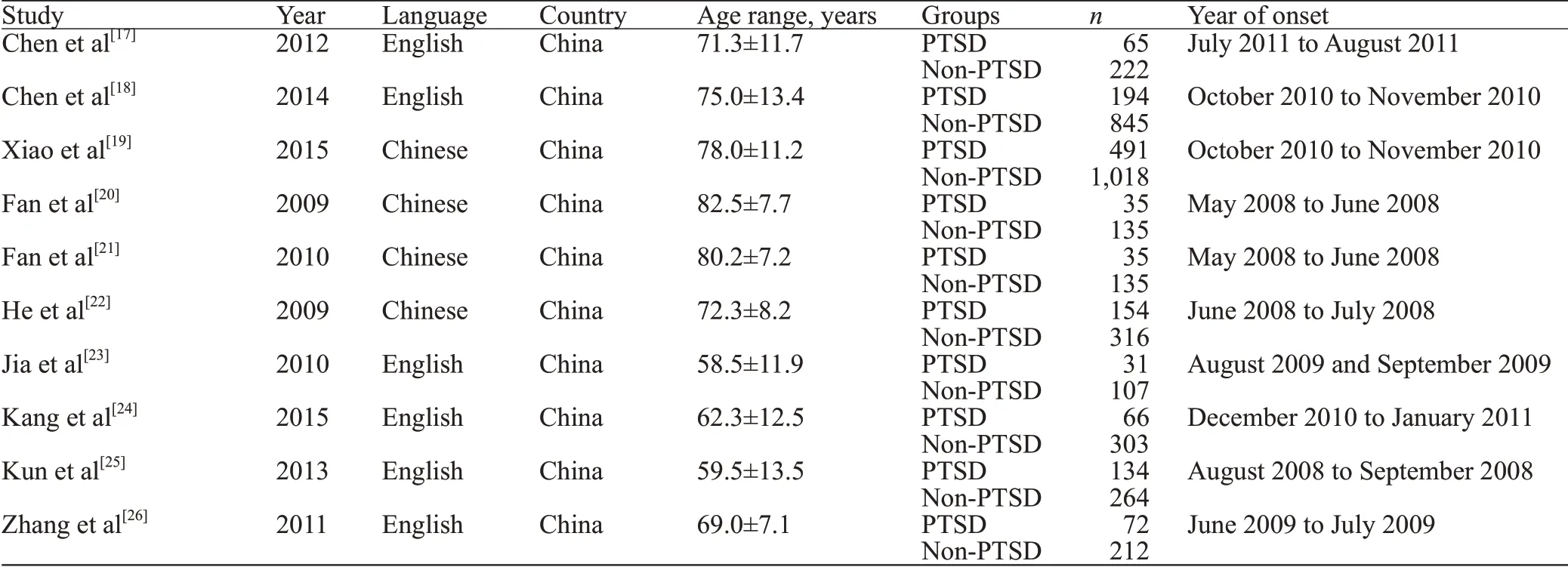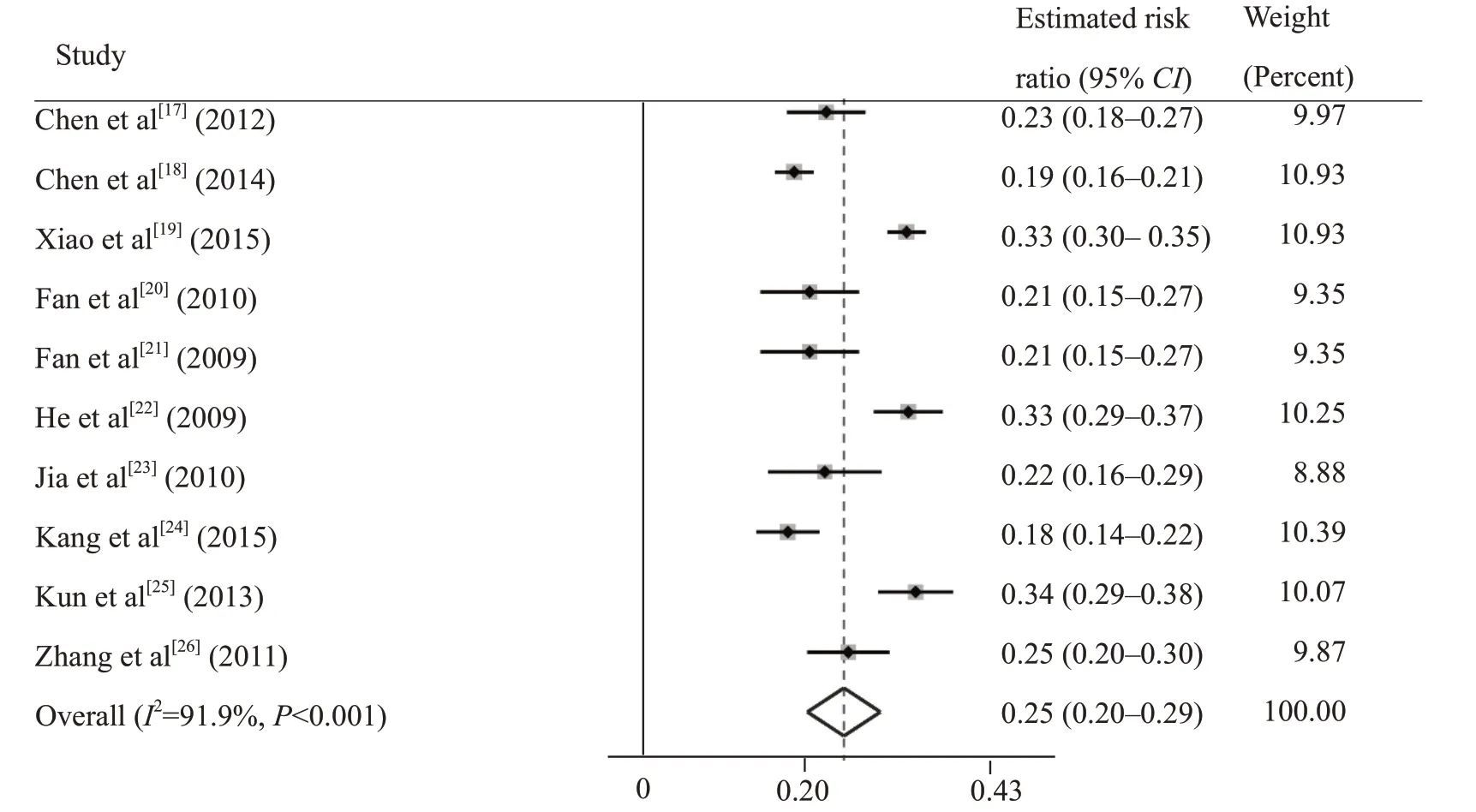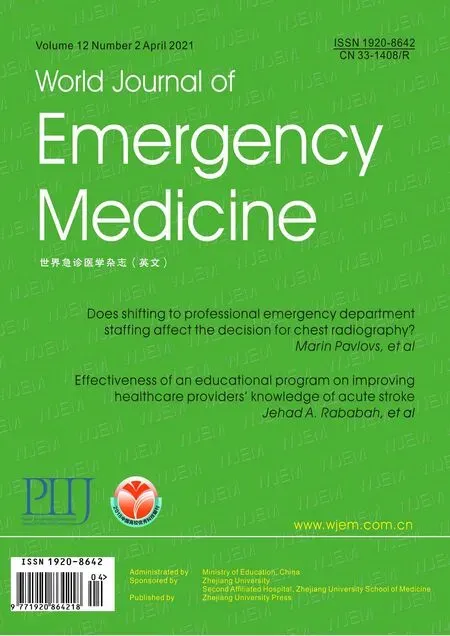Prevalence of post-traumatic stress disorder after earthquakes among the elderly in China: A metaanalysis
Yong Liang, Hong Zeng, Yu-geng Liu, Ai-min Xu, Wen-hong Liu
Emergency Medicine Clinical Research Center, Beijing Chao-Yang Hospital, Capital Medical University, Beijing 100043,China
KEYWORDS: Post-traumatic stress disorder; The elderly; Earthquake
INTRODUCTION
Compared with other natural disasters, earthquakes are unpredictable and disastrous, usually disposing the residents of the affected area to life-threatening danger.After a disastrous earthquake, both the destroyed infrastructure and the mental health of the affected residents need recovery. In the past several years,destructive earthquakes smashed Wenchuan and Ya’an,two cities of Sichuan, a province in Southwestern China.[1-3]The earthquakes, measuring higher than 7 on the Richter Scale, deprived tens of thousands people of their lives,and left millions of people with various physical and mental injuries.[4,5]According to a systematic review on mental health and psychosocial consequences of natural disasters in Southeast Asia, the reported rates of posttraumatic stress disorder (PTSD) symptoms following natural disasters range widely from 8.6% to 57.3%.[2]
One year after the Wenchuan earthquake, serious mental health problems among the aged survivors triggered social attention. The prevalence of anxiety and depression indicated that PTSD had become a social problem in areas struck by earthquakes.[6,7]In April 2013, five years after the Wenchuan earthquake, Ya’an,another city in Sichuan Province, was also hit by an earthquake, which not only had a serious impact on the lives of the local residents, but also seriously threatened the mental health of the aged.[8,9]Wenchuan earthquake,the most devastating natural disaster in China in the past 30 years, affected an area of more than 440,000 km2. It is estimated that due to this disaster, 400,000 urban people had lost their jobs, more than 5 million farmers’ crops were destroyed, and the total economic loss exceeded 150 billion dollars.[10]
Among the post-disaster mental problems, PTSD is the most harmful one. PTSD is a serious and lasting disorder that develops after exposure to events that cause psychological trauma, such as earthquakes or tsunamis.[11-13]After disasters, the elderly face more problems than other age groups. They are more likely to face a variety of health and mobility problems, such as inadequate financial resources, lack of personal transport, and insufficient social networks.[14-16]
There has always been a critical need to study the development of PTSD after earthquakes, especially among the elderly. Some research has been done, but the analysis methodology they used failed to reflect the comprehensive consideration of published articles. Therefore, a metaanalysis was applied in this study to evaluate the occurrence of PTSD after earthquakes among the elderly.
METHODS
Because this was a meta-analysis, all data were available online, with no ethical approval needed.
Literature search strategy
The person who conducted this study searched for articles comparing PTSD and non-PTSD in the elderly after earthquakes published from January 2000 to December 2018. Databases included PubMed, EMBASE,Cochrane Library, and China National Knowledge Infrastructure (CNKI). The following keywords were used: (1) post-traumatic stress disorder; (2) earthquake;(3) elderly. All these words are combined in the strategy with the Boolean operator “and”. The literature search did not restrict the language of publication. In order to maximize the specif icity and sensitivity of the search, the reference lists were studied as well to f ind other relevant studies that were not identif ied by the search strategy.
Study selection
After the initial selection, a review of potentially relevant research texts was conducted. The included studies must meet the following inclusion criteria: (1) studies comparing patients with and without PTSD; (2) including aged patients after earthquakes; (3) containing occurrence of PTSD; (4) available in full text.
The studies excluded were determined by the following exclusion criteria: (1) studies on other mental health problems; (2) patients suffering from other disasters; (3) studies lacking available data.
Data extraction and quality assessment
Two reviewers independently scanned the full text of the manuscript and extracted the following data from each eligible study: first author’s name, patient’s age and gender, country of origin, publication year, sample size, research period of each article. The methodological quality of this study was evaluated by a revised tool for the Quality Assessment of Diagnostic Accuracy Studies(QUADAS-2), which is an improvement over the original tool.[11]The second edition considers more transparent bias ratings and has applicability for primary diagnostic accuracy studies.
Statistical analysis
Review Manager (Version 5.0, the Cochrane Collaboration, 2011) was adopted to estimate the outcomes among selected reports. For continuous results,mean difference and 95% confidence interval (95%CI)were used. The heterogeneity ofI2statistics in the study was a quantitative method to measure the inconsistency of research. The study ofI225%-50% was considered low heterogeneity,I250%-75% was considered to be moderate heterogeneity, andI2>75% was considered high heterogeneous. IfI2>50%, the potential sources of heterogeneity were analyzed by sensitivity analysis. In addition, when the high heterogeneity was observed, a random-effect model was used. Conversely, the fixedeffect model was adopted considering the heterogeneity was low.
RESULTS
Searching process
The initial search found 784 related publications,among which 212 were selected after removing the duplicated publications. After the screening based on the titles and abstracts, 202 studies were excluded because of duplication, lack of relevance, incomplete data, or incomplete comparison. In the end, 10 articles were selected for this meta-analysis.
Characteristics of included studies
Detailed characteristics of the included studies,containing the first author’s name, year of publication,nation, recruitment time, age range of patients, sample size, and other parameters, were presented in Table 1. All these studies were published from the year 2000 to 2018.The sample size ranged from 138 to 1,509. In total, 1,277 patients with PTSD were included in these studies, and in parallel, 3,557 individuals without PTSD were included.
Results of quality assessment
The QUADAS-2 tool was used to evaluate the risk of patient selection problems in nine studies. In view of the applicability, there was no performance problem.In general, there were two studies with bias risk and six studies had low risk of bias. All the tests had no applicability problems. The detailed results of the quality assessment were listed in Table 2.
Results of heterogeneity tests
All the 10 articles reported the differences of PTSD occurrence in the elderly. Figure 1 showed that the heterogeneity in the studies was significant, andI2was 91.9% withP<0.001 for heterogeneity, which indicated that there were heterogeneities in the studies. Therefore,the random-effect model was used to evaluate the pooled estimates. The overall occurrence of PTSD in the aged was 0.25 with 95%CI(0.20-0.29).
Ten studies[17-26]analyzed the occurrence of postearthquake PTSD among aged males and females,respectively. The result of heterogeneities displayed the signif icant difference between males and females, and it indicated that a random-effect model should be adopted(P<0.001,I2=87.7%, relative risk [RR]=1.40, 95%CI[1.23-1.57]). The result of overall effect revealed a signif icant difference between males and females, which demonstrated that PTSD occurrence in females was higher than that in males.
Ten articles were included for the subgroup analysis of PTSD occurrence in the same province. The results of the heterogeneity test demonstrated that in the same province, the occurrence of post-earthquake PTSD in the aged was about 0.25. In Wenchuan city, the overall occurrence was 0.25 with 95%CI(0.20-0.30) (P<0.001,I2=89.1%) and in Ya’an city, the overall occurrence was 0.24 with 95%CI(0.14-0.35) (P<0.001,I2=95.3%).

Table 1. Characteristics of studies included in the meta-analysis

Table 2. Results of Q UADAS-2 quality assessment for each study
Results of sensitivity analysis and publication bias
To examine the stability of the outcome, a sensitivity analysis was needed. When Xiao’s study from 2015 was excluded, theI2value decreased from 91.9% to 87.1% in the heterogeneity part. It indicated that the results in this study were robust.
A funnel plot for occurrence after earthquakes in the aged was performed, with all the studies included. To some extent, the result implied that the presence of some publication bias since the symmetrical characteristic of the funnel plot was not ideal, which meant that publication bias in this analysis might be present.
DISCUSSION
In this study, the results showed that the occurrence of post-earthquake PTSD among the aged was 0.25 with 95%CI(0.20-0.29), which was consistent with other studies.[27-30]It has been reported that post-earthquake PTSD is more likely to appear among people over 65 years old, and the overall occurrence of post-earthquake PTSD among people is about 14.1%.[31]It shows that the ability of psychological adjustment of the aged after a disaster is weak, which leads to a high occurrence of mental and psychological crisis. The intervention should be provided to the aged population, and comprehensive measures should be adopted to offer practical psychological assistance.[30]
The occurrence was higher in females than in males, and the reason might be that women were more sensitive and vulnerable to external adverse stimuli than men, possibly due to different psychological characteristics, and women are more prone to traumatic re-experience symptoms.[25]In this study, the occurrence of PTSD in the same province showed little difference in China, which indicated that the occurrence of PTSD in the same region was similar.
Earthquake is one of the most devastating natural disasters. According to statistics from the Ministry of Civil Affairs in China, it has been conf irmed that in the Wenchuan earthquake, more than 70,000 people were killed, more than 400,000 were injured, 18,467 were missing, and 6.5 million people became homeless.[31,32]The Wenchuan earthquake not only caused huge loss of lives and properties, but also caused enormous trauma to the mentality of the victims.[33,34]Wenchuan earthquake and Ya’an earthquake highlight the importance of understanding the impact of trauma among disaster survivors.
PTSD is a psychological response after a disaster,and the occurrence ranges from 3.7% to 60.0%.[35]Aged survivors are more likely to have PTSD and other general mental illnesses than young adults, since the elderly have weaker physical and mental status and social supports.[36]Although the use of mental health services can signif icantly improve mental health, these services are only provided to less than 10% of survivors with mental problems.[35,36]More mental health services should be offered to the elderly to promote the recovery of their mental health in the aftermath of the earthquake.[33-35]
According to the characteristics of different gender, including psychology and behavior patterns,interventions such as psychological education, training and exercise can effectively reduce the occurrence of post-earthquake PTSD and other catastrophes.[35]Considering the characteristics of the aged population,the field investigation of their psychology and crisis intervention measures are needed.

Figure 1. Forest plot of post-traumatic stress disorder occurrence among the elderly after earthquake. Weights are from random effects analysis.
It is urgent to develop a diagnostic scale system with good reliability and validity and make it acceptable for the elderly. It is also important to create and evaluate various psychological therapies, and to gradually establish a PTSD intervention model suitable for the elderly. Nevertheless, group treatment, nursing, and rehabilitation are all necessary methods to promote the functional independence of aged patients. The treatment group should include doctors, nurses, physiotherapists,and psychotherapists.[33]
Study limitation
However, there are also some drawbacks of this study. Firstly, more indicators about post-earthquake PTSD occurrence among the aged should be included,which could be evaluated in further research. Secondly,more studies focusing on post-earthquake PTSD occurrence among the elderly in more countries could be included. Thirdly, further meta-analysis like metaregression was not conducted in our article because included data were not sufficient, which could be used to evaluated risk factors in a regression model.
CONCLUSIONS
The occurrence of post-earthquake PTSD among the elderly is high, and the occurrence in females is higher than that in males. However, in different areas of the same province, the occurrence shows little difference.
Funding:None.
Ethical approval:Not needed.
Conf licts of interest:There are no competing interests involving this work.
Contributors:YL wrote the first draft of this paper. All authors approved the f inal version.
 World journal of emergency medicine2021年2期
World journal of emergency medicine2021年2期
- World journal of emergency medicine的其它文章
- World Journal of Emergency Medicine
- Overlapping public health crises during the coronavirus disease pandemic
- Comparison of intraosseous access and central venous catheterization in Chinese adult emergency patients: A prospective, multicenter, and randomized study
- Empyema associated with vegetable foreign body aspiration
- A red herring: An unusual case of pneumothorax
- A case of a successful post-transcatheter aortic valve replacement His bundle pacing
